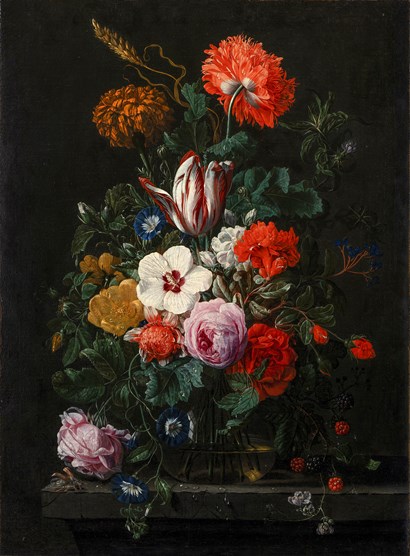This section will be available this Autumn.

Douwes Fine Art b.v.
henri fantin-latour
Henri Fantin-Latour (Grenoble 1836-1904 Buré) Vase de Pivoines, 1902 Oil on canvas 41 x 37 cm Signed lower left 'Fantin' The authenticity of this work has been confirmed by Sylvie Brame Provenance: Tempelaere, Paris; Tavernier, Paris; Colnaghi, London; Galerie Brame, Paris, 1978; Sotheby's London, 1978, lot 205; private collection, Europe; Sotheby’s London, 1989, lot 2; private collection, Europe; Sotheby’s London, 1996, lot 24; Noortman Master Paintings, Maastricht, bought at TEFAF 2004; private collection, Belgium; Douwes Fine Art, Amsterdam Literature: Mme Fantin-Latour, Catalogue de l'oeuvre complet de Fantin-Latour, Paris, 1911, n° 1937 on page 206

Stéphane Renard Fine Art
Workshop of Benedetto da Maiano (Maiano 1442-1497 Florence) Bas-relief of the Virgin and Child with Saint John the Baptist as a child Polychrome and gilded stucco in its original carved and gilded wooden frame H 76 x W 64 x D 13 cm (framed) Provenance: Coat of arms with the alliance arms of two Florentine families: the Compagni (on the left) and the Tornaquinci (on the right) We can estimate that around thirty copies of this bas-relief were probably made, half of which are in public collections (including the Bode Museum in Berlin (Germany – Inv. 1581), the Victoria & Albert Museum in London (United Kingdom – two copies), the Bargello and Stefano Bardini Museums in Florence (Italy), and the Hermitage Museum in Saint Petersburg (Russia) but this one is the only one bearing the coat of arms of its commissioners.

Franck Anelli Fine Art
claude corneille de lyon
Claude Corneille de Lyon (The Netherlands, The Hague 1500-1575 Lyon, France) Portrait of a wealthy merchant wearing a fur-lined coat and gold chain, circa 1560 Oil on panel 15 x 18 cm Certificate from Dr. Alexandra Zvereva This painting will be included in the supplement to the artist's forthcoming Catalogue Raisonné This unpublished small portrait fits naturally into the later works of one of the most illustrious portraitists of the French Renaissance. Referred to in contemporary documents by the name of his hometown, La Haye, he later became known simply as 'Corneille' until André Félibien, who believed him to be from the banks of the Rhône, added the name 'Lyon' in the index of his Entretiens. Born and trained in the Netherlands, probably in Flanders, the artist settled in Lyon as early as 1533. There, he succeeded Jean Perréal, the portraitist of Charles VIII and Louis XII, renowned for his intimate portraits with coloured backgrounds. By the mid-1530s, Corneille had gained such fame that he found himself painting the courtiers accompanying the king to Lyon, as well as the Sons and Daughters of France. However, unlike Perréal, his career was not that of a royal artist following the court. He never left Lyon, and his titles of "painter to the Dauphin" and later "painter and ordinary valet to the king" were purely honorary, primarily granting him the privileges of royal officers. The prominent citizens of Lyon, wealthy French and foreign merchants, high-ranking royal officers, well-to-do bourgeois, and magistrates made up the bulk of his clientele. Corneille created small-scale portraits for them, painted in just a few sitting sessions directly onto panels. Intended for family and close associates, these works had no official circulation and existed in only one unique copy, unlike portraits of the nobility, of which Corneille often made replicas that were widely circulated. The subject of this portrait is not a nobleman, despite his evident wealth. His attire is simple, a dark brown-black without any ornamentation, slashing, or jewels. The white ruff of his shirt is not starched. His high cap, fashionable in the 1550s-1560s, lacks a plume, a privilege reserved for the nobility, as it was associated with the feathers adorning knights' helmets. However, the man does possess a certain fortune, as evidenced by his fur-lined cloak of marten with wide lapels and a large gold chain with three rows of links, favoured by the Flemish. The medallion on the chain is cropped by the frame. This is almost certainly a prosperous merchant, eager to demonstrate his success and preserve the memory of his features for his family. The absence of any inscription on the reverse, giving the name of the subject, makes identification impossible, since no replica or engraving exists. Despite previous restorations, particularly to the face and background, the distinctive characteristics of Corneille’s art are clearly visible here, such as the rough sketching of the ear, the sloping shoulders that make the head appear slightly disproportionate to the torso, the treatment of the hair with individual strands, the brilliant irises crossed by an oblique ray of light, and the broader brushstrokes in the clothing.
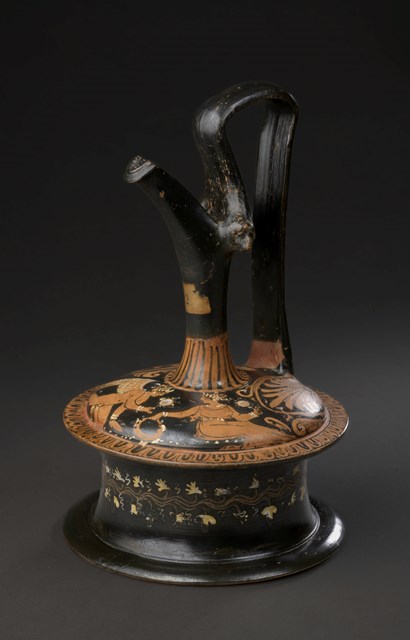
COLNAGHI
Attributed to the Menzies group Red-figure epichysis in terracotta with Hermaphroditos and a woman Greek, Apulian, circa 330-310 B.C. H 21 cm Provenance: Eugène Piot collection (1812-1890); his sale, 3 May 1870, lot n° 21; private collection, France; purchased from the above, 2022 Literature: F. Lenormand, Collection d’Antiquités Grecques recueillies dans la Grande-Grèce, l’Attique et l’Asie Mineure par M. Eug. P., Paris 1870, p. 16, n° 21 This epichysis is noteworthy for its provenance, as it was once part of the prestigious collection of Eugène Piot (1812–1890) - the French art critic, journalist, publisher, collector, and photographer - and it still bears his collection label. The present example also stands out for its above-average size and exceptional quality. It is in excellent condition and is typical of 4th-century BC Apulian Greek pottery. This vessel, characterized by its elegant neck surmounting a coiled body, was probably used to contain precious liquids intended for sparing use. Its delicate mouth seems ill-suited for serving wine, as has sometimes been suggested in the past, with some even describing such vases as “low-shaped oinochoai with flat bottoms.” Rather, they were most likely used for oil or perfume. The dropper-like mouth is flanked by two small, stylized masks in relief. The wide, disc-like shoulder of the vase has been decorated with particular attention to detail and form. The border is adorned with a frieze of eggs. A hermaphroditic Eros kneels and presents a mirror to a seated young woman, who also holds a mirror and a crown. On the reverse, an elegant arrangement of palmettes unfolds from the base of the handle and frames the central scene. The concave sides of the body are decorated with a vegetal frieze, overpainted in white and incised. Comparable examples are held at the Getty Museum in Malibu and the Musée Saint-Raymond in Toulouse; both have been attributed to the Menzies Group, active during the third quarter of the 4th century BC.

Axel Vervoordt
Jef Verheyen (Belgium, Itegem 1932-1984 Apt, France) Untitled Matt lacquer on round board 100 x 100 cm - Ø 80 cm Provenance: private collection, Belgium; collection Axel Vervoordt, 2003; private collection, Belgium Exhibition: Jef Verheyen, Lux est Lex, Wijnegem, 2004, cat. n° 60, ill. p. 93
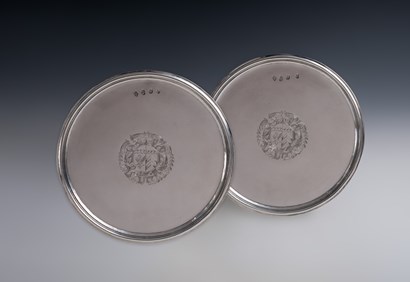
Kunsthaus Kende
Pair of Queen Anne tazze John Bache, London, 1703 Engraved Britannia silver Ø 23 cm, H 7 and 6.9 cm 513.1 gr and 504.8 gr Provenance: private collection, North America Standing on a central round foot, with moulded rim to the top side. The centre depicting an engraved coat of arms commemorating a marriage between two noble families. Outstandingly preserved and rare pair of Queen Anne tazze without repairs and showing their original preserved surface.

Floris van Wanroij Fine Art
rombout ‘pauli’ pauwels
Rombout ‘Pauli’ Pauwels (Mechelen circa 1625-1692 Ghent) The Virgin and Child Terracotta, sculpted on full round (contains restorations) H 52.5 x W 24 x D 23.5 cm Provenance: the Hulshoff Pol collection, Wassenaar, The Netherlands Literature: Neeffs, E. (1879), Histoire de la peinture et de la sculpture à Malines, Ghent, Vol. II, pp. 193-200; Nieuwdorp, H. (1977), De beeldhouwkunst in de eeuw van Rubens in de Zuidelijke Nederlanden en het prinsbisdom Luik, Brussels: KMKG, pp. 325-327 nrs. 294-298, p. 140, n° 103; Jacobs, A. & Vézilier, S. (2011), Fascination baroque: la sculpture baroque flamande dans les collections publiques françaises, Paris, pp. 116-121
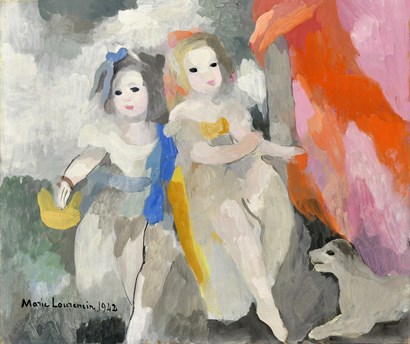
Galerie Taménaga
marie laurencin
Marie Laurencin (Paris, 1883-1956) Deux fillettes et chien, 1942 Oil on canvas 46 x 55 cm Signed and dated lower left 'Marie Laurencin 1942' Provenance: private collection Literature: Beaux-Arts, Paris, 24-30 July 1952; Daniel Marchesseau, Marie Laurencin, Catalogue raisonné de l'œuvre peint, Tokyo: Marie Laurencin Museum, 1986, vol. I, n° 804, repr. p. 327

Galerie BG Arts
Georges Clairin (Paris 1843-1919 Clohars-Carnoët) Portrait of Suzanne Lalique Oil on canvas 140 x 80 cm Signed 'Á Suzanne Lalique son ami G. Clairin' Provenance: property of Suzanne Lalique-Haviland; private collection, France Literature: Maritch-Haviland, N. de Léobardy, C., Lalique-Haviland-Burty Family Portraits, Limoges, 2009, p. 29, ill. in a group photograph, taken at Cours-la-Reine in Paris, showing Suzanne Lalique wearing this same dress for a costume ball to mark her birthday in about 1913 Georges Clairin is best remembered as an orientialist and portrait artist. He was a close friend and advisor to René Lalique. They regularly had dinner together and shared an interest in oriental objects, as well as travelling together to Venice. Clairin belonged to the bohemian world and painted Sarah Bernhardt, the celebrated actress of the day, in her different roles on numerous occasions. He also introduced her to Lalique, and she became one of Lalique’s most significant patrons for whom he designed jewellery. For both men, women were a constant theme of their work. As a family friend it is not surprising that Clairin should have painted Suzanne, René Lalique’s daughter, in costume for her birthday ball in 1913.

HELENE BAILLY MARCILHAC
Emile Othon Friesz (Le Havre 1879-1949 Paris) Bord de Mer, circa 1907 Oil on canvas 54 x 65 cm Signed lower right: Othon Friesz This work will be included in the forthcoming catalogue raisonné of the painted work of Emile Othon Friesz which is currently being prepared by the Galerie Aittouarès. Notice of inclusion n° 25361, delivered by Mrs. Odile Aittouarès on 3 January 2025

Almine Rech
hans op de beeck
Hans Op de Beeck (Turnhout, 1969) Crow, 2025 MDF, metal, polyamide, coating and bronze H 160 x W 80 x D 56 cm - Weight 39 kg Edition of 5 plus 2 APs Provenance: Studio of the Artist 'Crow' is a kinetic sculpture of a life-size flying crow. Powered by a mechanical system, the crow's flight creates the illusion of forward motion, although it remains suspended in place. 'Crow' evokes the world of fables and classic animated films, in which animals take on human traits. The work also alludes to the age-old tradition of mechanically animated figures, whose repetitive, joyless movements often inspire a quiet melancholy. At the same time, it is striking how lifelike and fluid such mechanically simplified movements can sometimes appear.

Jan Muller Antiques
cornelis kick
Cornelis Kick (Amsterdam, 1634-1681) Flowers in a glass vase Oil on canvas 62 x 49 cm 78 x 69 cm (framed) Authenticity and identification confirmed by Dr. Fred Meijer Provenance: Percey B. Meyer, London, 1953 (as Jacob van Walscapelle) Literature: Jan Kelch and Ingeborg Becker, Holländische Malerei aus Berliner Privatbesitz, Kaiser-Friedrich-Museums-Vereins und der Gemäldegalerie (Berlin, 1984), pp. 170-171 (as Jacob van Walscapelle); Royal Academy of Arts, London, 1952-53: Dutch pictures 1450-1750, catalogue p. 103, n° 563; Gemäldegalerie der Staatlichen Museen Berlin, 1984: Hollandische Malerei aus Berliner Privatsbesitz, pp. 170-171, pl. n° 84

Maurice Verbaet Gallery
paul van hoeydonck
Paul Van Hoeydonck (Antwerp 1925-2025 Wijnegem) Untitled, 1958 Oil on unalit 80 x 80 cm Provenance: Maurice Verbaet collection, Belgium Literature: Jan Ceuleers, Paul Van Hoeydonck, Antwerpen, Pandora Publishers, 2011, p. 160 & p. 287 Exhibition: KMSKA, Antwerp, Belgium, Fallen Astronaut. Hommage aan Paul Van Hoeydonck, 12 September 2025-12 October 2025





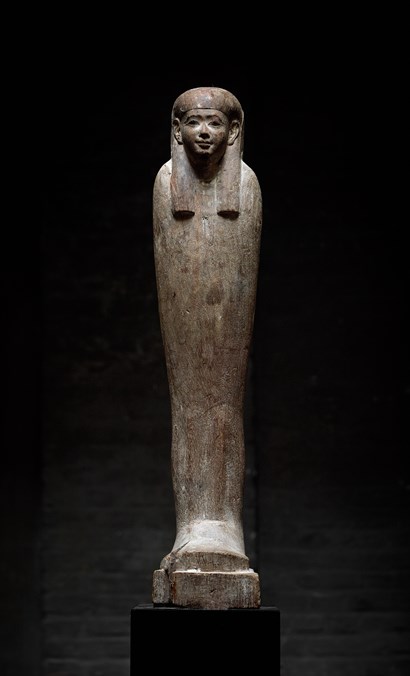

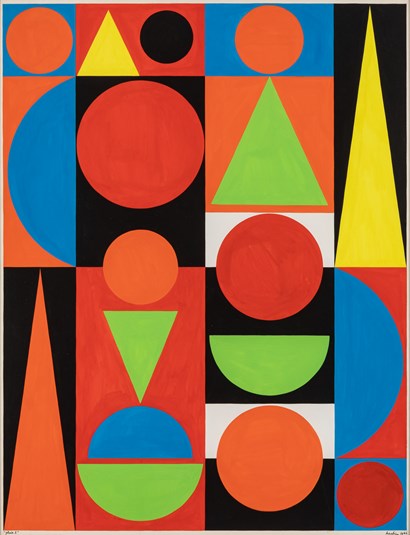

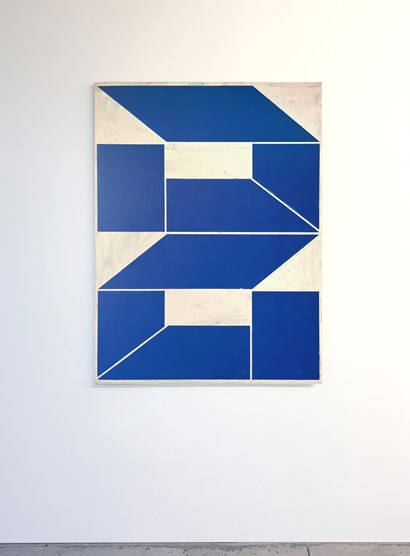

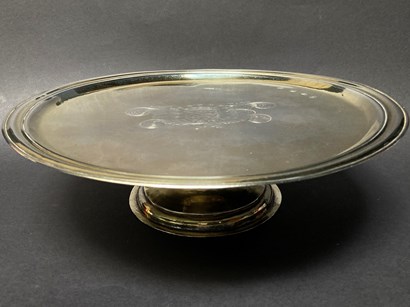




_LéaBelooussovitch_T638926698712577032.jpg?width=410&height=2000&qlt=90&scale=both&mode=max&format=jpeg)


